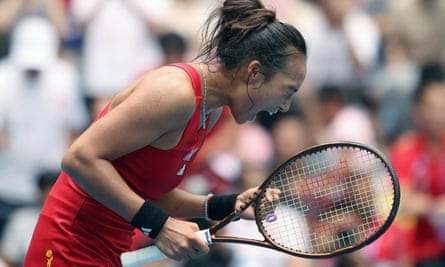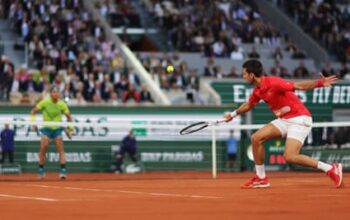A
Last month marked the one-year anniversary of Zhang Zhizhen, a 26-year-old tennis player from Shanghai. He made history by becoming the first Chinese man to rank in the top 100 of the world rankings, known for his powerful serve and signature long hair tied back with a headband. Just four months later, his fellow countryman Wu Yibing also broke into the top 100 and went on to win a title on the men’s tour, defeating American player Taylor Fritz in the process.
The emergence of Chinese tennis is evident in the improvement of players and facilities. While reaching the main draws of grand slam tournaments and achieving top rankings may seem minor, it highlights the lack of attention given to the sport in a nation that is primarily focused on basketball. Table tennis and badminton have traditionally been preferred over tennis in China.
Before last year, not a single Chinese man had achieved a victory at a major tournament in the Open era. Chinese supporters of tennis have had limited players to root for: in the women’s circuit, there was the captivating Li Na, who was by far the most accomplished singles player in the country and became the first Chinese singles player to win a grand slam title (claiming the French Open in 2011 and the Australian Open in 2014), as well as Olympic medalists and doubles specialists Yan Zi and Zheng Jie. However, apart from Li, there was never a consistent presence on the international stage, and the men’s game in particular fell behind.
This is undergoing a transformation. In a global landscape where countries with questionable human rights records use sports as a means of distraction and soft power (a long-standing tactic, but now more widespread and bold, as seen in the Saudi Pro League), the Chinese government has invested significant funds to create a tennis equivalent of the Belt and Road Initiative. This initiative involves China investing in infrastructure projects around the world to expand its sphere of influence.

Academies started by coaches and former players from the Western hemisphere have been successful, new stadiums have been constructed, and the sport has become a multibillion-dollar business. It currently holds the second largest market share globally, after the United States, including sectors such as merchandise, gear, events, and broadcasting.
Based on the worldwide report from the International Tennis Federation, there are approximately 20 million individuals participating in the sport on 30-40,000 courts in the country, ranking it as the top country for involvement. The sport is viewed as a middle-class activity associated with social status, similar to other countries. Vogue has described the “irresistible appeal of tennis in China” as not just a sports trend, but also a lifestyle and fashion phenomenon.
This intense and energetic effort has resulted in a group of exceptionally skilled males and females climbing the ranks and earning prestigious awards. Zheng Qinwen, a 21-year-old who can hit over 20 aces in a single match, claimed her first tour-level championship at the Palermo Open this past summer and made it to the quarter-finals of the US Open (eliminating Ons Jabeur along the way). Her triumph is reflected by Wang Xiyu, a previous junior world No 1 with an aggressive style, and Wang Xinyu, who won the women’s doubles title at the French Open this year.
Prominent international talent agencies like IMG have taken notice of highly acclaimed young individuals. Among them are influencers in the sport of tennis, like Shang Juncheng, who at the age of 17 became the first Chinese male to secure a singles victory at the Australian Open in January. This accomplishment garnered over 32 million views on the Chinese social media platform Weibo. His dynamic and unique playing style, coupled with his edgy earring, has led many to view him as a potential face of the sport in the future.

The Australian Open symbolizes the growth of tennis in China. In 2018, the distillery Luzhou Laojiao became the biggest Chinese sponsor of the tournament with a five-year deal worth $100 million. As part of the deal, one of the show courts was renamed after one of their liquors, and the tournament also partnered with four broadcast companies in China. The tournament’s chief revenue officer stated that China and the surrounding region are a top focus for the Australian Open.
Ignore the advertisement for the newsletter.
after newsletter promotion
This particular role sparked controversy when individuals advocating for the case of Peng Shuai’s disappearance – who had been silenced by her own government after speaking out about sexual abuse by a high-ranking official – were forcibly removed from the location. Similarly, the decision to cancel the Hong Kong Open in 2019 as a means of diverting attention from protests against authoritarian rule was another indication of questionable ethics.
This month, professional tennis has resumed in China after a three-year break caused by the pandemic. The Women’s Tennis Association had also boycotted the country, but they have now returned. However, the WTA’s leader, Steve Simon, promised that they would not come back until they were assured of Peng’s safety and liberty, regardless of any financial consequences. Unfortunately, this guarantee has not been kept, largely due to the 10-year contract that was signed for the WTA Finals to take place in Shenzhen.
Two weeks ago, Iga Swiatek emerged as the victor at the China Open in Beijing, while Wang Xiyu claimed her first tour title in Guangzhou. In the men’s competition, Jannik Sinner of Italy earned a massive gold cup (also in Beijing); Alexander Zverev of Germany triumphed at the Chengdu Open; and Karen Kachanov of Russia won in Zhuhai. On Sunday, Hubert Hurkacz and Andrey Rublev will compete for the men’s Shanghai showpiece title.
It is encouraging to witness a group of promising and talented young Chinese athletes advance in the sport. China’s significant growth and investment in tennis has received praise from observers like Maria Sharapova. However, it is disconcerting to realize that this success may be used as a way for the government to divert attention from their human rights abuses, such as the treatment of the Uyghur population and the censorship faced by players like Peng and other citizens. As a result, it is not surprising that during press conferences, this new generation of Chinese stars tends to avoid discussing their home country.


